| |
"The Texas Chain Saw Massacre is widely agreed to be one of the best – if not the best – horror films of all time. I'd say it's perfect. It's a perfect thing. There's nothing wrong with The Texas Chain Saw Massacre that anyone can pick up. The acting's great, the style, the mood, everything slots together. It's a perfect jewel of a film." |
| |
Stephen Thrower, author of Nightmare USA and Beyond Terror |
You see that? A pretty bold statement, you might think, but one that I and a good many other genre fans happen to agree with. The Texas Chain Saw Massacre is sublime cinema and everything a great modern horror film should be. And then some. And there are three things that perfect cinema doesn't need. The first is a remake. The second is a sequel. The third is to become a franchise. But for the money men at least, exploitation cinema by its very nature is about squeezing your initial investment dry. So if the first one makes money, then let's give it another go. The brand name's been established, the product road-tested, and a sizeable portion of a modern horror audience will buy almost anything if the right boxes are ticked.
It's hard to think of a horror classic from the 70s and 80s that hasn't been subjected to at least one of the above listed indignities or even all three. That happened to Halloween. It happened to Friday 13th. It happened to A Nightmare on Elm Street (seriously, did anyone actually see the remake of this?). It also happened to A Texas Chain Saw Massacre. But wait, the first sequel was also directed by Tobe Hooper. That's a good thing, right? And when the BBFC insisted on something like 20 minutes of cuts, distributor Cannon abandoned its plans for a UK release. Way-hey! That's what we want to hear! How violent could this film be to prompt that sort of response? This did, of course, present a bit of a problem for UK horror fans in pre-download days, but that's what pirated VHS tapes were invented for.
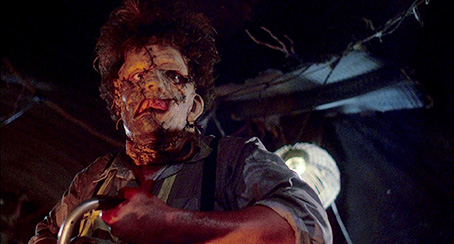
When I did get to see The Texas Chainsaw Massacre 2 (the "Chain Saw" of the original had been transformed into a compound word) I wasn't sure how to react. It's a response I relived when watching it again on Arrow's spiffy new multi-disc release. Technically, it is a sequel. It does, after all, take place some years after the events in the original film and makes specific reference to them. But it's also... hell, I'm not sure I really know quite what it is.
First up, a little scene setting for hopeful newcomers. It kicks off with a re-run of that narration and scrolling text that so effectively opened the original film, one that brings us up to date on more recent ominous events. The only thing is, this time the narrator seems in one heck of a hurry, like he's being paid by the job and has another three voice-overs lined up immediately afterwards in the studio next door. Then the action begins. Loudly. We're somewhere in Texas and two coked-up yuppies are tooling down the highway firing a big gun at signs and giggling insanely at their own behaviour.
OK, let's pause here for a second. I say these guys are yuppies because that's what they're called in the extra features. I probably wouldn't have guessed otherwise. Perhaps it's now too long after the event. The driver looks like a college quarterback with his dad's dress sense and the twerp with the gun appears to have fallen through a time warp from a version of 1960s' drug culture that only ever existed in the minds of filmmakers. Seriously, I've spent long evenings in the company of people who have all been dosing for hours on magic mushrooms and none of them giggled and squealed like this ludicrous idiot.
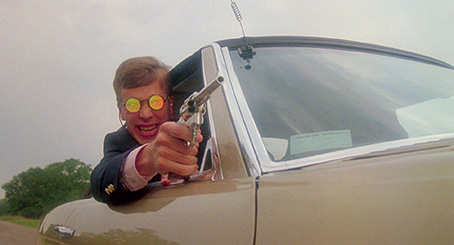
We're then introduced to Vanita 'Stretch' Brock (Caroline Williams), the sort of hard-nosed, take-no crap female lead that the genre just loved in the post-Alien 80s. She's a DJ at a ramshackle radio station and the dreadful wankers in the car think it would be fun to call her up and babble at her like lunatics on a monkey hunt. She quickly tires of them (welcome to our world, baby), but can't shut them off because the station has a phone system that requires the caller to hang up first or the phone stays connected. Say, what? I tried hard to imagine the conversation that took place when they had this phone system installed. "You know what I think would be really good, to get a phone line where the call can only be ended by the caller. That way, if we get a raving idiot or someone who is screaming threats down the phone, we can't cut them off or ring out for help. Won't that be brilliant?"
Eventually, inevitably, the wankers piss off the wrong guys by forcing their pickup truck off the road in a game of chicken. A while later, this very same vehicle appears before them (quite how this truck managed to speed invisibly past the wankers' high performance car – whose number plate is FAH Q, which is rather funny – and sit laying in wait for them is frankly beyond me), and guess who's on board? The boys soon find out when the truck reverses alongside them and Leatherface appears with the corpse of his dead brother strapped to his chest, waggling his chainsaw and shaking his body like a Caribbean dancer. There's no turning off because they're trapped on what appears to be a mile-long bridge, and before quarterback boy has the sense to change gear and accelerate (he's in a sporty Mercedes, the truck is running in reverse – go figure), Leatherface has sawn through the side of his car and lopped the top of his head off.
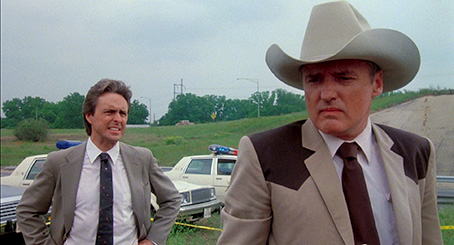
The next day, the highway patrol boys are picking through the squishy remains of the subsequent crash when out-of-jurisdiction Lieutenant 'Lefty' Enright (Dennis Hopper!) shows up to confirm his worst fears, that the murderous family who killed his son Franklin (the whiny, wheelchair-bound victim from the first film) are at large in the district. Nobody in authority takes him seriously, of course. Then Stretch shows up with a tape of the phone call that the wankers were still making when Leatherface cut their car up. It's the very thing Lefty needs to kick-start his investigation. So what does he do? He tells her to bugger off and returns to his drinking. Eventually, he has a change of heart and convinces her to play the recording of the murder on her radio show. It's a broadcast heard by the Sawyer family patriarch (credited here as "Cook" and again played by Jim Siedow, the only returning cast member from the original film), and despite it having all the hallmarks of a cop-engineered trap, the brood decide they need to pay Stretch a visit. Why? Well killing her, one of them reasons, will silence any witnesses to their latest crime. Eh? It was broadcast on the radio! There are probably hundreds of witnesses by now! Oh right, yeah, they're mad. Good get-out clause...
OK, it must have occurred to Hooper long before he decided to deliver this sequel that there was no way in hell he was going to top the original. Take another look at that quote at the top, which is sampled from an extra on this very release. A perfect horror film. You can't beat perfect. You might perhaps equal it, but not with a sequel to a film whose searing effectiveness was in no small part down to it coming out of nowhere. When you sat down for The Texas Chain Saw Massacre for the first time in the 70s, you really couldn't prepare yourself for what you were about to experience. And what unfolded was unlike anything you'd ever seen. By 1986, we'd not only seen the original film an unhealthy number of times, but also had the likes of The Hills Have Eyes, The Evil Dead, A Nightmare on Elm Street and a whole string of violent would-be imitators and low-grade slashers under out belt. How could Hooper possibly make a sequel that was even more unendurably frightening than The Texas Chain Saw Massacre? Short answer, he couldn't. He knew he couldn't. Nobody could. Hooper clearly understood this (he's a seriously intelligent guy) and instead chose to make a very different film. Pretty smart, huh? Well that's the theory.
Instead of making a scary horror movie, Hooper chose to turn Texas Chainsaw 2 into a semi-comic reworking of the earlier film. And if you doubt this was the intention, take a look below at the film's original poster sitting side-by-side with the one for John Hughes' brat pack comedy The Breakfast Club. It's a piss-funny parody that also clues you in to Hooper's intentions for this belated sequel. The question is whether the decision to laugh up the horror was a sound one or a folly that blots the original's pedigree. And that, dear reader, appears to be very much in the eye of the horror beholder.
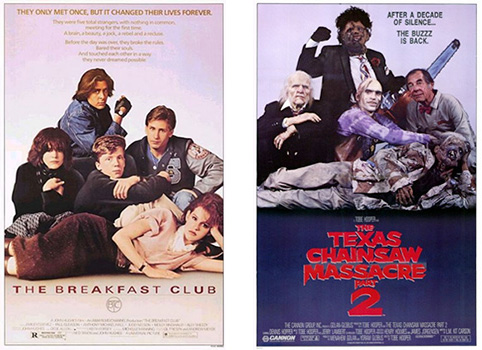
The problem for this particular beholder is that all these years later I'm still not sure how I'm supposed to react. Is the film scary? No. Is it funny? Well, no. Is it boldly original in the manner of its predecessor? Hardly. Is it colourful? Oh yeah, it's definitely that. Too colourful if the truth be told. It's this, coupled with the film's sometimes jaw-dropping disregard for realism, plus one of the cheesiest music scores I've heard in a long while, that transforms the film into a cinematic carnival sideshow, The Texas Chain Saw Massacre re-imagined as a brightly coloured, cheerfully violent and blackly comic pantomime.
The Texas Chain Saw Massacre was genuinely ground-breaking cinema, a bold, brilliant and confrontational product of a time when American studio and indie films alike were challenging and exciting. This was a genuinely thrilling period for the American horror movie, one of genre reinvention and revisionism and exciting new talents like George Romero, Wes Craven, John Carpenter, David Cronenberg and – yes! – Tobe Hooper. Each new genre delight made you wonder what further terrors these sublimely demented gentlemen would come up with next. And you couldn't wait to see it. Then along came the 80s, and we were encouraged to laugh instead of cower at the horror. The slasher film was born and audiences started rooting for the killer instead of the victim. It was a time of horror icons and movie merchandising, of Freddie Kruger gloves and Jason Voorhees masks. Yes it was all rather fun. But scary? Almost never. What I wanted from Texas 2 was a film that spat in the face of these trends. What I got instead was one that eagerly embraced them. Instead of challenging the audience, it pays lip service to their expectations, packing in all the expected elements plus a few designed specifically to push the envelope a little, and dresses them up in a candy coloured coating.
The potent sense of realism that so distinguished Texas Chain Saw has been traded in here for a comic book look and sensibility that neuters the elements that first made the earlier film so frightening. The family no longer live in a grubbily workaday house, but in a vast underground Aladdin's cave of tunnels, lights and retro-fitted Gothic. They've moved up in the world financially, but have descended both physically and metaphorically, a comment on 80s affluence and rampant private enterprise we are assured. Well, maybe. And what of the iconic Leatherface? Gone is the terrifying and incomprehensible face behind the mask of horror film legend. Here he's presented as a confused and curious man-child, one hamstrung by an evolving curiosity about girlies. His infatuation with Stretch provides her with a get-out-of-jail-free card that poor Sally Hardesty in the first film never had, and boy does he get to hammer home the chainsaw-as-penis metaphor. This softening of one of the best monsters in horror movie history reaches a would-be comical peak when he's mocked by his family with a sing-song "Bubba's got a girlfriend!" and the big lug gives a comical "oh shucks you got me" shrug.
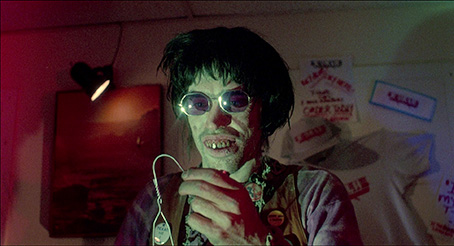
But he's not alone here. Having disposed of Edwin Neal's HitchHiker in the first film's climax, Hooper serves up a replacement in the shape of his twin brother Chop-Top. Excuse me? His twin brother? Yep, apparently HitchHiker had a twin brother who was serving in Vietnam when the earlier events took place. I'll just bet he was a model soldier. This sort of thing, of course, is one of a number of favourite get-arounds pulled by franchise sequels when a previously killed off character finds fan popularity. Remember Whistler's return from the dead early in Blade 2? Did anyone really buy into that? It was great to have him back, but his resurrection required a sizeable "oh come on" swallow. And fine actor though replacement loony Bill Moseley is (if you want to see how scary he can be when given the chance, check out his turn as the murderous Rufus in The Devil's Rejects), here he takes Neal's disturbingly authentic twitchiness and plays it to the gallery, to the point where at times he come across more like a drugged-up and damaged son of Beetlejuice than HitchHiker's twin brother.
Although energetically played by Caroline Williams, I found Stretch a little annoying and never interesting enough to engage or empathise with. It probably didn't help that Hooper has her participate in a near-exact rerun of the first film's climax, a curiously unadventurous move that reminds us just how damned convincing Marilyn Burns was in the earlier film. Back then, I genuinely quaked for Sally Hardesty's fate, but here I cared little whether Stretch lived or died. Even Dennis Hopper fails to deliver the hoped-for dividends, a cult casting coup that sees early restraint later give way to uncontrolled madness and wild-eyed screams of "Bring it all down!" Easy to forget that this was the very year he managed to scare us all shitless as Frank Booth in Blue Velvet. That said, he is at the heart of the film's most oddly enjoyable sequence, when he wordlessly shops for chainsaws and swings and thrusts them like martial arts weapons to the bemusement of the ageing proprietor. That Hopper is reputed to have later claimed that Texas Chainsaw 2 was the worst film he ever appeared in is something we'll let slide.
Now it's worth stating here that a good many horror fans have no problem with any of this. At least they don't now. On its release the film took a caning for many of the reasons outlined above, but in the intervening years there appears to have been a general change of heart, the reasons for which are concisely outlined by Stephen Thrower in his interview on this very release. These are two very different films, we are repeatedly reminded, and we shouldn't be trying to compare them to each other, yet the title openly encourages us to do just that. Thrower draws comparisons with Evil Dead II, a more comedic and outlandish sequel to a scary original, and that's fair enough. But while Evil Dead II built smartly and wittily on the larger-than-life style of its predecessor, Texas Chainsaw 2 is so stylistically divorced from its infamous forebear that it would take a genetic scientist to establish a family connection.
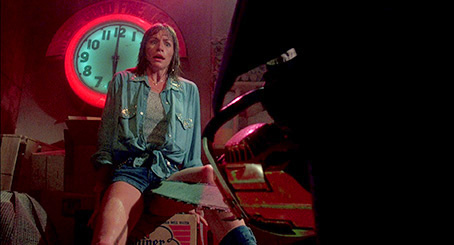
But again, is any of this actually a bad thing? Well it seems to depend on your taste in horror cinema, or perhaps even just the breadth of that taste. And I'm fully aware that despite all of my above complaints, were this not a sequel to one of the finest horror films of the modern age then I'd probably enjoy it a lot more than I actually did. It certainly has energy and definitely delivers as a comic-book, Troma-esque grindhouse piece. But the cheerful rejection of realism robs the horror of its threat and its potential bite (one poor sod sustains enough hammer blows to the head to reduce it to jam, but survives with hardly a scratch and only a small puddle of blood) and none of the would-be comedy is as darkly funny as the "Look what your brother did to the door!" moment from the original film.
Oh, I don't know. The film now has a cult following and I know that it goes against the grain for me not to be championing its apparent virtues, but it just doesn't click for me. The horror is too wacky and divorced from reality to horrify, the characters are too overacted to be scary, and although it's played largely for laughs I didn't find it funny. That didn't leave me with too much. Elsewhere on this disc it's referred to as a satire on capitalism and Reaganomics. Maybe it is, but I'm not completely convinced. Certainly this subtext is never as purposefully developed as the anti-consumerism of George Romero's Dawn of the Dead or the politics of poverty in Wes Craven's underrated The People Under the Stairs. But maybe it's just me, and if you love watching horror movie icons doing horror movie stuff and doing it loudly, and you're happy seeing the scariest family in the genre's history transformed into the Three Stooges, then you may well have a ball.
Say what you like about the film itself (and I did, as you'll have gathered if you've got this far), but it's scrubbed up really well for this splendid 1.85:1 HD transfer. Of course, if you thought the visual style was too garish then this only helps to emphasise that, but if you're a fan you'll likely have never seen it looking anywhere near as good as it does here. The contrast feels about right, delivering solid blacks without punishing too much of the shadow detail, and the colours are lively (and there is some bright colouring here in the set dressing and lighting). Despite a few remaining dusts spots, the image is generally clean. The film grain is visible but hasn't suffered any obvious enhancement. And don't trust the screen grabs here – it looks far better on a decently calibrated plasma screen..
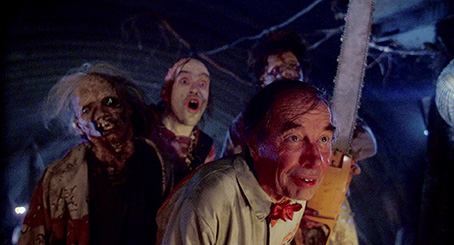
The Linear PCM 48 stereo soundtrack is in spanking shape, with a decent dynamic range, no trace of noise or damage and some distinct stereo separation in places.
Disc 1: Blu-ray only
It Runs in the Family (87:55)
Look at that running time. Intimidating perhaps for the casual viewer, but for the rest of us this means we'll be getting a proper making-of documentary instead of a half-assed EPK, and this is just such a beast. Comprised of interviews with many of the key crew and cast members, it's divided into six individually titled and end-credited chapters. In The Texas Screenplay Massacre, scriptwriter L.M. Kit Carson talks about his first meeting with Hooper (this is a good one), his eventual involvement in Texas Chainsaw 2, the decision to plump for a comic approach, the last minute budget cut, continually rewriting the script during the production (something he found "thrilling"), and plenty more. The Art of Mayhem covers the look of the film, including the cinematography, the lighting and the production design. A Cast of Characters is all about, well, the cast, and includes interviews with several of the surviving primaries. Prime Meat focuses on our favourite horror make-up man Tom Savini, who is as entertaining and enthusiastic as ever and repeatedly credits his talented crew (what a guy). In Father of the Saw, the cast and crew talk about working with Hooper (who although conspicuous by his absence here is well represented elsewhere in this package), who apparently lived on a diet of cigars and Dr. Pepper. Finally, Requiem for a Sequel talks about the post production and release, and the film's gradual elevation to its current cult status. It's all good stuff, and gold for fans of the film.
Director's Audio Commentary
A most welcome commentary track on which Tobe Hooper is joined by David Gregory, who directed the smart 2000 documentary The Texas Chain Saw Massacre: The Shocking Truth. Inevitably Hooper discusses the casting of the key roles and working with the actors, but also covers the 80s audience demand for gore, the move towards comedy and abandonment of realism, working with screenwriter Kit Carson, Tom Savini's makeup effects, the locations, the economic advantage of buying skeletons from India (you heard me), and a whole lot more. He also reveals that the RV from the first film was wrecked when it ran into a cow. Whatever your views on the film itself, this is a most worthwhile and sometimes entertaining listen.
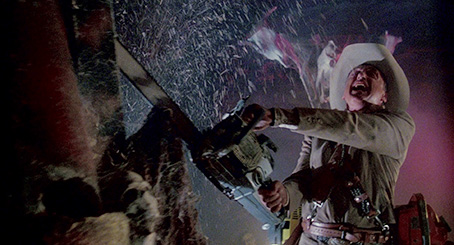
Actors' Audio Commentary
One thing I've learned is that if you get a group of three or more actors or crew members together and stick them in front of a microphone then they're going to spend a significant portion of their time arsing about, making comical observations and laughing at just about anything. And the commentary here, which features actors Bill Moseley and Caroline Williams and makeup effects wizard Tom Savini is no exception. Moderated by Michael Felcher (well, sort of), it's a lively chat with some engaging stories and plenty of piss-taking of both the characters and each other. Williams and Moseley are both brimming with boisterous enthusiasm, though Moseley says "awesome" far too many times for my liking, while the normally vocal Tom Savini sometimes gets lost in the hubbub. Fun, but a little exhausting at times.
Still Feelin' the Buzz (28:31)
Stephen Thrower, author of Nightmare USA and Beyond Terror, analyses the film and finds meaning where there probably is none, but is so considered in his delivery and so persuasive in places that I really began to feel I was missing out on something that everyone else seemed to be getting. It didn't last long. He does also cover the elements he regards as flaws, including what he neatly calls the violation of Leatherface.
Cutting Moments with Bob Elmore (14:41)
Former stuntman and the body behind this new incarnation of Leatherface during the action scenes discusses landing the job, the physical preparation required, breaking his wrist during the bridge scene and being directed by Hooper ("He screamed at me so much I couldn't believe it"). He also describes working on the film as the highpoint of his industry career.
Alternate Opening Sequence (1:56)
The creepier original opening credits, which have more of a 70s horror feel than the ones that replaced them. And better music. The sequence appears to have been hauled off VHS tape and is framed 4:3.
Deleted Scenes (10:37)
Another rescue from what looks like VHS consists of three deleted scenes from an excised sequence in which the family go out on a night-time meat hunt, first slaughtering a group of rowdy yuppie sports fans, then a trio leaving a cinema after watching a trashy horror movie. You see what I resisted saying there? The yuppie slaughter in particular emphasises the film's rejection of reality (if this was how the brood spent their evenings the entire state of Texas would be in lockdown by now), and there are some direct references to Evil Dead II here. Also included is a single shot that was cut from the climax.
Original Trailer (1:01)
A deadly serious trailer that gives no indication the film is played for laughs.
Image Gallery
84 high quality monochrome production stills, with plenty of behind-the-scenes material.
The other supplementary material is presented both on Blu-ray and DVD. Only the DVD was provided for review purposes, but even that looked damned good.
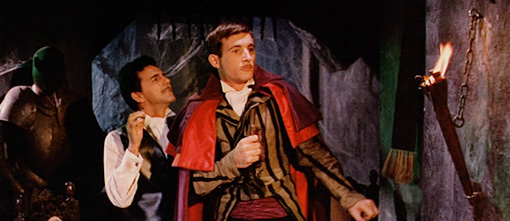
The Heisters (10:01)
Iif you had no foreknowledge of this 1964 short and were being quizzed about who directed it, I'm willing to bet that you'd die of old age before you guessed it was Tobe Hooper. A fast-paced and oddball surrealist period comedy, it follows the fortunes of three gentleman robbers as they flee from the authorities, count up their spoils, argue, fight, and perform scientific experiments on a bug. Set largely in a castle cellar and gorgeously shot and lit in Techniscope, it plays like a melding of Roger Corman's Poe films and The Running Jumping & Standing Still Film-era Spike Milligan, Peter Sellers and Richard Lester. Technically accomplished silliness with smarts and a lot of style. Great fun.
Eggshells (1:25:33)
As extra features go this is an absolute doozy, being Hooper's rarely seen debut feature, restored and accompanied by an optional director's commentary (more on that below). And it's the director that provides the only real link to the headline feature, as this is a very different film to The Texas Chainsaw Massacre 2. Indeed, if you bought the disc because you're a serious fan of the later film, there's a chance you'll have a few problems here. Eggshells was made back in 1969 and is a cracking example of 60s counterculture cinema, where story plays second fiddle to scenes in which hip chicks and dudes hang out, take drugs, philosophise, talk politics and have sex. The normal rules of narrative cinema do not apply, as the primary aim of any such film is not to tell you a story, but to capture something of the spirit of the time and place, something Eggshells does with disarming aplomb.
It kicks off with an unnamed girl, possibly about to enter her first year at college, riding in the back of a pickup truck to Austin and arriving in the midst of a sizeable but peaceful anti-Vietnam war protest. We can presume she's hitched the ride but it's never confirmed one way or the other. There's a lot of that here. The focus then switches to a property shared by a group of friends who socialise and discuss politics and personal relationships, seemingly unaware that there may be a spiritual presence in the house. And if you think that last bit makes the film sound like a trial run for Poltergeist then you're way off the mark. Here the spirit, or whatever it actually is, co-exists but never interacts with the human inhabitants. There's even a suspicion that it intermittently takes on human form in the shape of the house resident whose presence seems to go unnoticed by anyone else.

But storyline be damned. In the spirit of the best examples of 60s counterculture cinema, Hooper uses this setup to experiment with technique and form and the results are sometimes thrilling. The content and easy pace of the conversations are very much a product of the time and place, but are married to some vivid documentary material, some creative psychedelia, sequences that only make sense in metaphoric terms (including a memorable end-of-an-era final scene), and technically impressive stop-motion, including a brilliantly designed and executed sequence from the viewpoint of the spirit as it hurtles around the house and takes residence in the cellar. Hooper's experimental sensibility even prompts him to cover the preparations for a party and the event itself from a single and seemingly disadvantaged angle and make it work for the movie. The folk and sitar driven score certainly roots the film in the late 1960s, but the songs are actually pretty damned good.
On a technical level alone, Eggshells is a masterful piece of work. The camerawork is sometimes superb, particularly the excellent coverage of the opening anti-war protest. Seriously, this is some of the best footage of 60s protest events I've seen and is up there with Haskell Wexler's work in the climax of Medium Cool (which was also released in 1969). It's also nice to see police and protesters getting on so well, despite a couple of fabulously framed but ominous close-ups of holstered pistols and anxiously gripped batons. I've little doubt that anyone who has seen the film will recall the sequence that begins with a pan across a breeze-hit gutter that locks on to a paper plane as it magically takes flight as the camera reaches it, then drifts through the trees and crashes into the communal house and explodes. Just who is this supremely talented cameraman? Why Hooper himself. He was also one of the editors. And yes, the editing is also as sharp as a Japanese scalpel, in the montage work of the opening, in the cutting of specific scenes and in the silky smooth manner in which these elements are stitched together. Watching this you can't help but think that Hooper could have made his name in any film-related career he had chosen to follow.
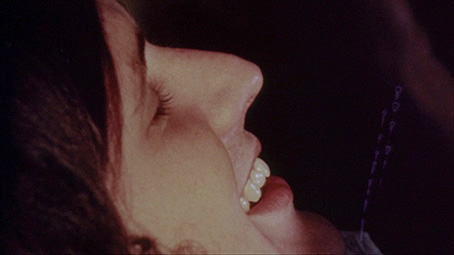
What really catches you out is how well the film has dated. As a record of a very American time and place, it feels far more grounded in reality than a good many of its more widely seen contemporaries. It also feels very much a portrait of 60s American counterculture made by someone who was part of and creatively charged by that movement, rather than the work of a talented but detached observer. A good many of those coming to this release for the main feature will probably be left scratching their heads, but speaking personally, I loved it.
The film has been restored from what the commentary suggests was the only available print. There is still some damage and a fair few speckles of dirt, and the colours are often very muted, but in other respects this is a very nice job.
Eggshells Commentary
It's always a pisser when you discover an early work by a filmmaker who later made it big (having a rep is still big in my book), and for whatever reason they're reluctant to talk about it. Maybe their style has changed over the years, maybe they're embarrassed by the minuscule budget or what they now perceive as political or cinematic naiveté, who knows. If you've been taken by the film yourself this can feel like a betrayal, someone whose work you admire telling you not to be so silly and come take a look at what they've been doing recently instead. Not Tobe Hooper, bless him. Together with his friend Louis Black, one of the people responsible for restoring what for years was thought to be almost a lost film, Hooper provides a fascinating look back at the making of what was clearly a very personal work for him, and one he and Mr. Black still hold in high regard. Actors and locations are discussed, as are some details about how scenes were shot (but not how he got that paper plane to fly so perfectly on cue), while the thinking behind some scenes is covered in quite a bit of detail, which may help those left a little confused by this approach to filmmaking to unravel a few plot details. The claim made by both men that this is a rare honest film about American counterculture is one I enthusiastically share, and somehow it cheered me to hear Hooper say of the time and the ever-present spectre of the Vietnam war that "the style of life was totally wonderful and it was great not to be over there."
Trailer Reel (23:46)
Now this is rather fun. Tobe Hooper's career is mapped out by trailers for all of his major films, which are strung together in chronological order. It kicks off with a spoiler-riddled trailer for The Texas Chain Saw Massacre (the fate of just about every victim in the film is shown here) through key works like Salem's Lot (good trailer this one), Poltergeist, Lifeforce, The Texas Chainsaw Massacre 2 (same one as above) right up to the 2009 Mortuary. I'm sure Hooper himself could do without watching this and seeing how many times in his later career he is referred to as "the director of Poltergeist and The Texas Chain Saw Massacre" as if he'd done nothing else since.
Interview with Tobe Hooper (23:22)
A welcome and most engaging interview with Hooper himself, who in his usual amiable growl talks about the politics of capitalism and homelessness, the influence on his work of the Vietnam war, the problems he faced on the filming of Eaten Alive, remaking Invaders From Mars, casting Heather O'Rourke in Poltergeist, and more.
A 100-page booklet on Tobe Hooper is also included with the retail release but was not supplied with the review disc. Arrow's on site describes it thus:
Exclusive perfect bound book covering everything you wanted to know about Tobe Hooper, chainsaws and more! Featuring new writing on the director's early works by Brad Stevens, an investigation of Tobe Hooper's three-picture Cannon deal by Calum Waddell, new writing on The Texas Chainsaw 2 by Kenneth Muir, a look at the film's long battle with the BBFC and an exclusive interview with Hooper by Stefan Jaworzyn, author of The Texas Chainsaw Massacre Companion, rounded off with an appraisal of the highs and lows of the Texas Chainsaw franchise by Joel Harley, all illustrated with archive stills.
I tried, I really did, but all these years later I still can't get into bed with Texas Chainsaw 2 the way other horror fans have. Maybe it's just too loud, too silly, too bloody 1980s, I don't know. I realise this shuts me out of the very sort of cult following I'd normally be carrying a banner for and leaves me open to charges of missing the point, but I'm not going to pretend that I think it's a misunderstood masterpiece just to be part of the crowd. However – and this is a big bloody however – I'm still going to highly recommend this Blu-ray/DVD release from Arrow for the simple reason that it's quite possibly the best, most comprehensive and most lovingly produced UK home video release I've watched all year. The transfer is first rate, there are deleted scenes, an alternate opening, two enjoyable commentaries, and some smartly produced and informative documentary material. On top of that, you not only get a rarely seen early Hooper short film, but his captivating debut feature in its entirety, restored, and accompanied by a fine commentary track. The packaging is apparently also a joy. Even if you have a fondness for other Hooper films but are ambivalent about Texas Chainsaw 2 you should own this release for the supplementary material alone, and if you're a fan of the film then you should buy it immediately and then hunt out the people at Arrow who produced this release and hug every one of them.
|